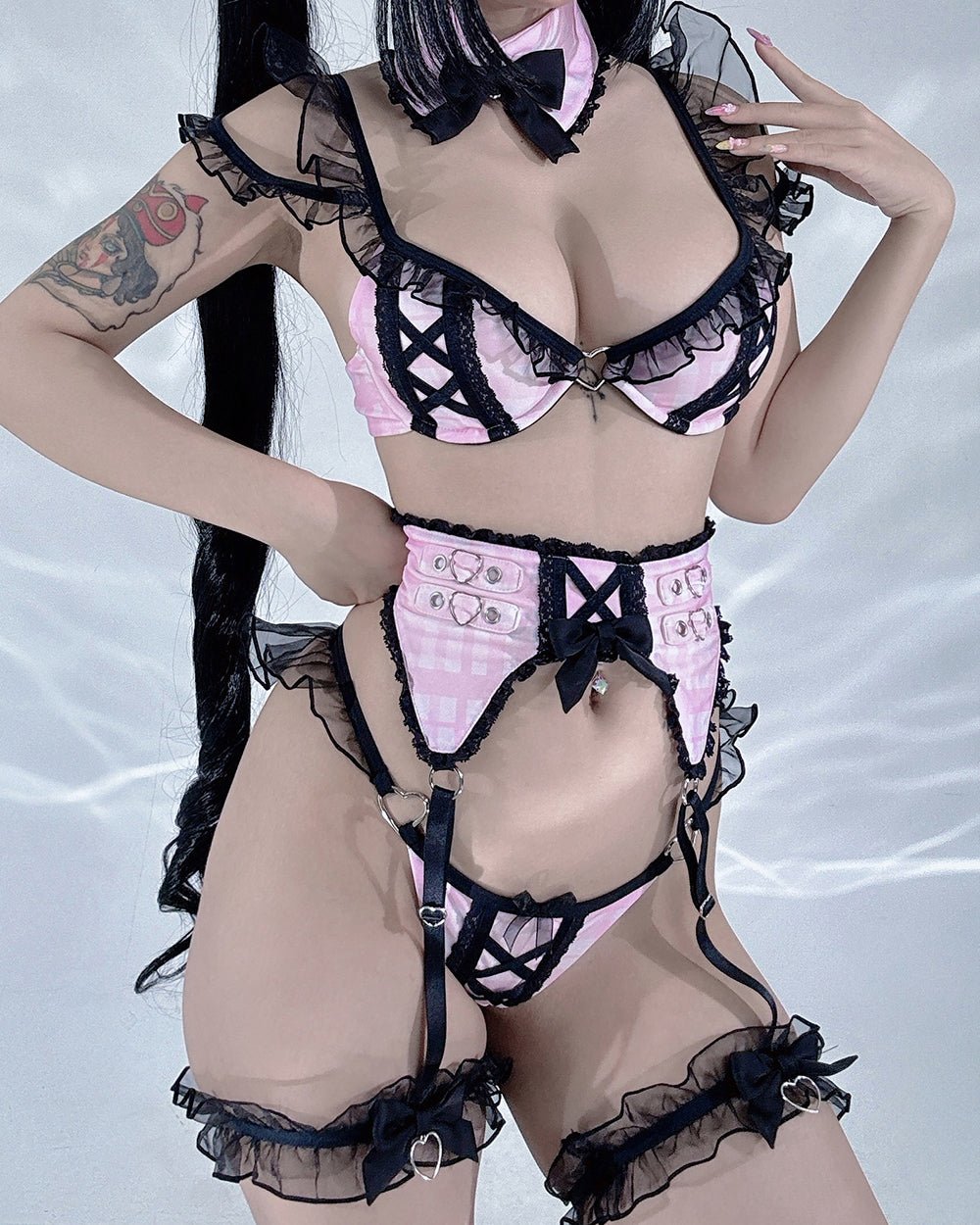What Is Shibari? Art & History of Japanese Rope Bondage
When someone searches "what is shibari," they're often seeking to understand both the cultural origins and contemporary applications of this captivating Japanese art form. The term shibari, literally meaning "to tie" or "to bind" in Japanese, represents far more than simple rope bondage. It's a practice that bridges art, intimacy, psychology, and aesthetic expression.
This ancient tradition, originating from its martial roots, has evolved into a globally recognized form of artistic expression, therapeutic practice, and alternative fashion inspiration, allowing people to enjoy Shibari in diverse ways.
What Exactly is Shibari?

Shibari refers to the Japanese art of decorative rope bondage, emphasizing aesthetic beauty, emotional connection, and the interplay between physical restraint and freedom. Unlike Western bondage practices that often prioritize function over form, Shibari focuses on creating visually striking patterns that honor the natural asymmetry of the human body while establishing deep psychological connections between participants.
The practice encompasses several related terms that newcomers often encounter. Kinbaku, meaning tight binding, specifically refers to the erotic subset of Shibari that emphasizes sexual intimacy and emotional intensity. While all kinbaku is Shibari, not all Shibari involves erotic elements—many practitioners engage with rope work purely for artistic, meditative, or therapeutic purposes using only ropes and specific techniques.
Contemporary Shibari manifests in various forms, from private intimate relationships to public art performances, photography sessions, and fashion inspiration. The aesthetic principles that guide traditional Shibari—emphasizing natural asymmetry, impermanence, and the beauty found in imperfection—have influenced modern alternative fashion, including anime-inspired clothing designs that capture the visual essence of rope work without actual restraint.
History & Origins
From Hojojutsu to Art Form
Shibari traces its roots to hojojutsu, a martial art developed during Japan's feudal period (1467-1603) used by samurai to restrain prisoners. This wasn't merely functional restraint—different knot patterns and rope placements conveyed information about a person's social status, the severity of their crimes, and even their fate. The psychological impact was as important as the physical restraint, with specific ties designed to instill shame and submission in prisoners.
The transformation from martial technique to artistic expression began during the late Edo period (1603-1868) when kabuki theater adopted Japanese bondage as a dramatic tool. Theater practitioners adapted the harsh hojojutsu techniques into safer, more aesthetically pleasing patterns that conveyed stories through visual imagery. Actors portraying captured heroes, enslaved characters, or tragic lovers wore intricate rope designs that enhanced the emotional impact of their performances.
The Birth of Modern Shibari
The transition from theatrical tool to erotic art occurred in the early 20th century, largely due to the influence of Itoh Seiyu, who is considered the father of modern kinbaku. His work, influenced by traditional ukiyo-e woodblock prints and kabuki aesthetics, introduced Japanese rope bondage to photography and underground erotic culture. Seiyu's artistic vision emphasized the rope's ability to enhance and frame the human form rather than simply restrain it.
Post-World War II Japan experienced a surge in the popularity of kinbaku, largely driven by specialized magazines, such as Kitan Club, which featured artistic photography that showcased rope bondage. This period established Shibari's dual identity as both artistic expression and intimate practice, laying the groundwork for its eventual global spread. After World War II, the practice evolved to build trust between partners in new ways.
Meaning & Philosophy Behind Shibari
The Wabi-Sabi Aesthetic
Shibari is deeply rooted in the Japanese philosophical concept of wabi-sabi—the acceptance and celebration of imperfection, impermanence, and incompleteness. This philosophy contrasts sharply with Western ideals of symmetry and perfection, guiding shibari practitioners to embrace natural asymmetry and find beauty in temporary moments.
In practice, wabi-sabi is manifested through rope patterns that follow the body's natural contours, rather than imposing artificial symmetry. A bound body becomes a canvas for exploring how restraint can highlight rather than hide individual uniqueness. The temporary nature of rope work, designed to be tied and untied, reinforces the philosophical emphasis on impermanence and the preciousness of fleeting moments.
Trust, Vulnerability, and Connection
Modern Shibari emphasizes the psychological dynamics between the rigger (the person tying) and the bunny (the person being tied). This relationship requires extraordinary trust, clear communication, and mutual respect. The practice creates space for exploring vulnerability in a safe, consensual environment where both participants can experience heightened awareness and emotional connection.
The rope becomes a medium for nonverbal communication, with tension, placement, and pattern conveying emotions and intentions. Many practitioners describe shibari sessions as deeply meditative experiences that foster presence, mindfulness, and intimate connection beyond what words can achieve.
Basic Shibari Techniques & Ties
Foundational Knots
Beginning shibari students focus on mastering essential techniques that form the building blocks of more complex patterns:
Single Column Tie serves as the foundation for nearly all shibari work, creating a secure anchor point around a single limb or object. This fundamental technique teaches proper tension control and forms the basis for chest harnesses, leg ties, and suspension systems.
The Double Column Tie secures two points simultaneously, maintaining safe spacing between them, and is commonly used for wrist restraints or as a component in full-body harnesses. Mastering this tie develops an understanding of load distribution and safety considerations.
Lark's Head Knot provides secure attachment points for more complex patterns, often used when connecting rope to suspension points or creating decorative elements within larger designs.
Progressive Skill Development
Advanced shibari ties, such as the Takate Kote (box tie), create elaborate chest harnesses that showcase the aesthetic principles of traditional Shibari. These patterns require months of practice to execute safely and beautifully, as they involve complex anatomical considerations and precise tension management.
The Futomomo (thigh tie) showcases how decorative patterns can accentuate the natural curves of the body, creating visually striking geometric designs. These ties serve as excellent practice for developing even tension and understanding how rope interacts with different body types.
Practitioners typically spend 4-6 months mastering floor tie patterns before progressing to suspension work, which requires advanced understanding of load-bearing principles, safety protocols, and emergency procedures.
Benefits & Appeal
Artistic and Creative Expression
Shibari offers a unique medium for artistic expression that combines physical craft, aesthetic sensibility, and emotional depth. Many practitioners find deep satisfaction in creating beautiful patterns that enhance the human form while exploring themes of vulnerability, strength, and connection.
The practice develops patience, attention to detail, and aesthetic sensitivity as riggers learn to read their partner's responses and adjust their approach accordingly. Each scene becomes a collaborative artwork created through trust and communication.
Therapeutic and Mindfulness Applications
Western practitioners are increasingly approaching Shibari as a mindfulness practice, similar to meditation or yoga. The intense focus required during tying and being tied creates a meditative state that many find deeply relaxing and emotionally healing.
The physical containment of rope can provide a sense of safety and grounding for individuals dealing with anxiety, trauma, or overwhelming emotions. Many describe the experience as creating a "safe space" where they can explore vulnerability without judgment or pressure, allowing them to feel secure within the practice.
Alternative Fashion and Aesthetic Inspiration
The visual appeal of Shibari has influenced fashion designers, photographers, and alternative clothing brands who draw inspiration from rope patterns and kinbaku aesthetics. This influence is evident in everything from high-fashion runways to alternative clothing collections that capture the essence of rope work through printed fabrics and design elements.
MOEFLAVOR's shibari collection exemplifies this aesthetic translation, creating anime-inspired pieces that capture the visual beauty of traditional kinbaku through soft, comfortable materials. These designs enable individuals to incorporate shibari aesthetics into their everyday wear while celebrating the art form's visual heritage.
Shibari-Inspired Fashion You Can Wear Safely
While traditional shibari uses real rope and complex technique, many people simply love the look of rope patterns without wanting the intensity or risk of actual tying. That’s why shibari-inspired fashion has grown so quickly, especially in alternative, anime, and cosplay communities.
Brands like MOEFLAVOR reinterpret classic rope patterns into soft, stretchy, wearable lingerie. Instead of rope tension, these pieces use elastic straps and body-hugging silhouettes to mimic the visual geometry of kinbaku while staying comfortable and beginner-friendly.
If you want the rope aesthetic without the rope practice, explore the Kill Rope Shibari Collection, a line designed to recreate the iconic diamond patterns and body framing associated with traditional rope art.
Shop the Kill Rope Shibari collection
These designs let you enjoy the artistry and symbolism of shibari in a wearable, everyday-safe way — perfect for photoshoots, self-expression, or intimate fashion styling.
How to Learn Shibari

Educational Resources and Safety First
Learning Shibari responsibly requires comprehensive education that prioritizes safety, consent, and proper technique. Quality educational resources include specialized books, such as "The Beauty of Kinbaku," online platforms like Shibari Study with free videos, and hands-on workshops led by experienced instructors.
Anatomy education forms a crucial foundation for safe practice, as understanding nerve pathways, circulation, and pressure points helps prevent injuries. Many serious students invest time in learning basic first aid and recognizing signs of circulation problems or nerve compression.
Choosing Appropriate Materials
Traditional Shibari uses natural fiber ropes, typically 6-8mm jute or hemp, cut to specific lengths (usually 8 meters for most applications). Beginners might start with cotton rope for its softness, though it lacks the grip and aesthetic appeal of traditional materials.
Rope care involves proper cleaning, conditioning, and storage to maintain safety and longevity. Natural fiber ropes require regular maintenance to prevent fraying and maintain their binding properties.
Community and Practice
The shibari community emphasizes mentorship, ongoing education, and responsible practice. Local workshops, practice groups, and online communities offer opportunities for learning, skill development, and discussions on safety.
Progressive learning typically begins with self-tie exercises and eventually progresses to working with partners, always prioritizing clear communication, established boundaries, and safety protocols.
How to Practice Shibari Safely
Establishing Clear Boundaries
Safe shibari practice begins with comprehensive negotiation that covers physical limitations, emotional boundaries, experience levels, and specific interests or concerns. These conversations should occur before any rope work begins and continue throughout the learning process in the same way that other BDSM activities require discussion.
Ongoing consent requires regular check-ins during sessions, with safe signals for adjustment or stopping. Many practitioners use traffic light systems (red, yellow, green) or other agreed-upon communication methods to maintain clear dialogue, even during intense experiences, and establish safe words for different situations.
Physical Safety Considerations
Understanding anatomy and recognizing danger signs prevents serious injuries. Key risk areas include major nerve pathways in the arms and shoulders, circulation points at joints, and breathing considerations for any ties that affect the chest or neck area.
Session duration should remain conservative, especially for beginners, with most experts recommending maximum 20-30 minute sessions for load-bearing ties and regular circulation checks for any restraint lasting more than a few minutes.
Practitioners should maintain safety tools, including sharp scissors for emergency rope cutting, and possess knowledge of proper aftercare procedures to ensure participants' comfort and well-being after sessions, thereby helping them feel secure and cared for.
Nerve Damage Prevention
The most serious risks in Shibari involve potential nerve damage from improper pressure or duration. Key vulnerable areas include the radial nerve in the upper arm, the median nerve in the wrist, and various pressure points around joints.
Prevention strategies include avoiding prolonged pressure on nerve pathways, maintaining regular movement and position changes, and responding promptly to any numbness, tingling, or loss of sensation. Practitioners learn to recognize early warning signs and respond appropriately to prevent lasting damage to the skin and underlying tissues.
Emergency protocols should include immediate release procedures, recognition of serious symptoms that require medical attention, and post-session monitoring for potential delayed complications.
Misconceptions About Shibari
Beyond BDSM Stereotypes
One common misconception positions Shibari purely within BDSM contexts, overlooking its rich artistic, cultural, and therapeutic applications. While kinbaku does involve erotic elements and may explore BDSM fantasies, many practitioners engage with rope work for entirely non-sexual purposes, including art, meditation, performance, and personal growth.
The practice encompasses a whole range from purely aesthetic rope work to deeply intimate experiences, with practitioners choosing their level of engagement based on personal interests and comfort levels. This kink can be approached in numerous ways depending on individual preferences.
Cultural Sensitivity and Appropriation
Western adoption of Shibari raises important questions about cultural sensitivity and respectful practice. Responsible practitioners educate themselves about the cultural origins and philosophical foundations of their field, rather than simply adopting techniques without understanding their context.
This includes learning proper terminology, understanding the principles of the wabi-sabi aesthetic, and approaching the practice with respect for its Japanese origins while adapting thoughtfully to contemporary contexts.
Shibari-Inspired Fashion & Modern Applications
Fashion and Aesthetic Translation
The visual appeal of Shibari has inspired fashion designers and alternative clothing brands to create pieces that capture the aesthetics of kinbaku without compromising functionality. These designs translate rope patterns into printed fabrics, strategic cutouts, and decorative elements that evoke the art form's visual beauty.
MOEFLAVOR's approach to shibari-inspired fashion demonstrates how traditional aesthetics can influence contemporary clothing design. Their Kill Rope Shibari Lingerie and Kill Shibari Crossed Out Dress capture the intricate diamond patterns and asymmetrical beauty of traditional rope work through comfortable, wearable designs.
The plus-size inclusivity in these collections reflects modern values while honoring the body-positive aspects of traditional Shibari, which celebrates natural body diversity rather than promoting narrow beauty standards for women and people of all genders.
Photography and Performance Art
Shibari has gained recognition in contemporary art circles through photography, performance, and installation work that explores themes of vulnerability, trust, and human connection. Artists use rope work to create powerful visual statements about relationships, power dynamics, and the beauty found in temporary moments.
The Kill Shibari Spiked Bodysuit exemplifies how fashion can reference these artistic applications while remaining accessible for everyday wear, cosplay, and self-expression, often creating a sense of empowerment and aesthetic pleasure.
Digital and Virtual Expressions
Online communities have expanded Shibari's reach through educational content, artistic photography, and virtual workshops, making learning more accessible. These platforms also foster discussions about safety, technique, and cultural appreciation, benefiting practitioners worldwide, often featuring free videos and tutorials.
For more on how alternative Japanese subcultures influence modern fashion, explore our Jirai Kei fashion breakdown—a darker, emotionally expressive style rooted in kawaii aesthetics. And if you're looking for bold, inclusive looks this season, don’t miss our guide to sexy plus-size Halloween costumes designed for confidence, comfort, and standout visual flair.
Want the beauty of rope art without the intensity of real tying? Discover our Kill Rope Shibari designs made for comfort, photography, and self-expression.
FAQ
Why do people like Shibari?
People are drawn to Shibari for various reasons, including artistic expression, intimate connection, mindfulness practice, and aesthetic appreciation. The combination of visual beauty, emotional depth, and meditative focus appeals to individuals seeking meaningful experiences beyond conventional activities. Many find that Shibari offers unique opportunities for trust-building, creative expression, and personal growth within a framework of safety and consent, allowing them to enhance their relationships emotionally and physically.
What is the English of Shibari?
Shibari translates directly to "to tie" or "to bind" in English, though these simple translations don't capture the full cultural and artistic significance of the practice. More comprehensive descriptions might include "Japanese rope bondage," "decorative rope art," or "aesthetic rope tying"; however, practitioners often retain the original Japanese terminology to honor the practice's cultural origins and distinguish it from Western bondage practices.
How much rope for a beginner shibari?
Beginners typically start with 4-6 pieces of rope, each approximately 8 meters (26 feet) long, although requirements vary based on body size and the specific techniques being learned. Many instructors recommend starting with 6mm cotton rope for comfort and forgiveness while learning basic knots and tension control of ropes. As skills develop, practitioners often expand their rope collection and may transition to traditional jute or hemp materials.
How to practice Shibari safely?
Safe shibari practice requires comprehensive education about anatomy, clear communication protocols, proper equipment, and emergency procedures. Essential safety measures include learning to recognize circulation problems and nerve compression, establishing clear boundaries and consent protocols, maintaining sharp scissors for emergency cutting, and starting with simple techniques before progressing to complex ties. Regular safety education and a conservative approach to session duration help prevent injuries, and many people take a course to learn proper safety techniques.
How to avoid nerve damage in Shibari?
Preventing nerve damage requires understanding vulnerable anatomical areas, avoiding prolonged pressure on nerve pathways, and recognizing early warning signs, such as numbness or tingling. Key prevention strategies include limiting session duration (especially for arm ties), avoiding tight bindings around the upper arms, elbows, and wrists, making regular position changes, and responding immediately to any signs of nerve compression. Practitioners should learn proper anatomy and maintain conservative approaches to pressure and duration to prevent any form of torture or unintended harm.
Key Takeaway
Shibari represents a rich cultural tradition that has evolved from martial origins into a contemporary practice encompassing art, intimacy, therapy, and aesthetic expression. Understanding what Shibari truly means requires appreciating its philosophical foundations in wabi-sabi aesthetics, its emphasis on trust and communication, and its potential applications beyond traditional BDSM contexts.
Whether pursued as artistic expression, mindfulness practice, or intimate connection, Shibari demands respect for safety protocols, cultural origins, and the well-being of all participants. The practice offers unique opportunities for personal growth, creative expression, and meaningful connection when approached with proper education, clear communication, and ongoing commitment to safety, creating experiences that help people feel more connected to themselves and their partners.
Modern interpretations of Shibari, including fashion collections like MOEFLAVOR's shibari-inspired pieces, demonstrate how traditional aesthetics can influence contemporary culture while making the art form's visual beauty accessible to broader audiences. These adaptations honor the original practice while creating new avenues for appreciation and self-expression, allowing more people to enjoy shibari aesthetics in diverse and accessible ways.
Citations:
- https://goop.com/wellness/sexual-health/what-is-shibari/
- https://assets.pubpub.org/hbv2sijd/71614044580204.pdf
- https://peachandcream.com/blogs/cookbook/what-is-shibari
- https://www.binataverna.com/post/the-origin-history-of-shibari
- https://www.menshealth.com/sex-women/a32145034/what-is-shibari/
- https://en.wikipedia.org/wiki/Japanese_bondage
- https://dojodolls.com/blogs/blog-posts/the-first-knots-to-master-as-a-shibari-beginner-building-skills-step-by-step
- https://ropestudy.com/courses/101/lessons/reducing-risk/topic/nerves/
- https://shibarinews.com/beginners-guide/faq/nerve-problems-in-shibari
- https://shibarinews.com/beginners-guide/faq/how-to-avoid-risks-in-shibari














